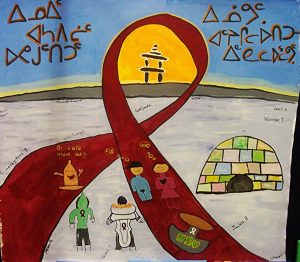In their paper, “Because we have really unique art”: Decolonizing
Research with Indigenous Youth Using the Arts, Flicker et al. (2014) outline the process and results of the project for Taking Action!, an Indigenous-youth-led project on using art for HIV prevention. The paper opens with the following quote by France Trépanier:
Art can be medicine, a survival tool, an antidote. Art is our identity, our place, a sign of our presence on this planet. It is medicine as it helps healing because we’ve been through so many things. Art is for the people. It can help build our communities.

Mural Created by Inuit Youth Participants of Puvirnituq, Nunavik
The goal of the project was to “explore the links between community, culture, colonization, and HIV” (p. 16). Twenty Indigenous artists and over one hundred youth (age 13-29) participated from six different communities across Canada. The project was guided by a committee of Indigenous youth. The paper is full of commentary from the participants, who found the workshops to be fun and helped them talk about HIV. The opportunity to learn ” traditional art forms, such as carving, throat singing, drumming, and painting, was an effective way to focus on the issues while learning about, and in some cases, reclaiming, parts of their heritage” (p. 22). The authors emphasize the importance of giving participants choice in what they did. As an educator, one comment particularly stood out to me: “You talk so much you don’t really remember, but if you do art you are going to remember it all” (p. 23).
At the end of the workshops, the participants had created pieces that they were proud of. These were shared with the community, such as paintings showcased locally and songs played on the radio. The project helped the participants challenge stereotypes about Indigenous youth. “Using the pieces as a springboard for discussion was suggested as a way to help people open up when talking about ‘hard things'” (p. 26).
Reference:
Flicker, S., Yee Danforth, J., Wilson, C., Oliver, V., Larkin, J., Restoule, J.-P., Mitchell, C., Konsmo, E., Jackson, R., & Prentice, T. (2014). “Because we have really unique art”: Decolonizing Research with Indigenous Youth Using the Arts. International Journal of Indigenous Health, 10(1), 16–34. https://doi.org/10.18357/ijih.101201513271